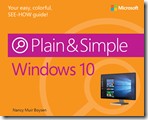Sample chapter: Making Windows 10 Accessible
 Windows 10 offers several features to address accessibility needs, such as Magnifier to enlarge content on the screen, Narrator to read content to a user, the ability to adjust screen brightness or contrast, and the option of speaking text rather than typing it. This chapter from Windows 10 Plain & Simplecovers these accessibility features.
Windows 10 offers several features to address accessibility needs, such as Magnifier to enlarge content on the screen, Narrator to read content to a user, the ability to adjust screen brightness or contrast, and the option of speaking text rather than typing it. This chapter from Windows 10 Plain & Simplecovers these accessibility features.
In this section:
-
-
-
-
- Using Magnifier
- Setting up high contrast
- Adjusting screen brightness
- Making elements on your screen easier to see
- Changing mouse settings
- Changing keyboard settings
- Using Touch Feedback
- Working with Narrator
- Using Speech Recognition
- Turning on Closed Captioning
- Using visual alternatives for sounds
-
-
-
Windows is used by millions of people around the globe. Some of those people face challenges in using a computer. Some have dexterity issues such as carpal tunnel syndrome or arthritis and need to adjust mouse and keyboard settings to make providing input easier. Others face visual challenges that make content on the screen difficult to read. Some might need help hearing sounds or require an alternative way to connect with the spoken word in videos, such as close captioning.
Windows 10 offers several accessibility features to address these needs, such as Magnifier to enlarge content on the screen, Narrator to read content to a user, the ability to adjust screen brightness or contrast, and the option of speaking text rather than typing it. All of these tools make using a Windows 10 computer very easy.
Read the complete chapter here .